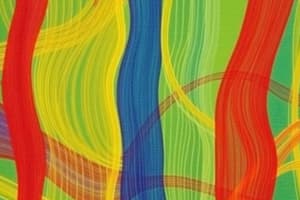Podcast
Questions and Answers
What is the main food of silkworms that produces the best silk?
What is the main food of silkworms that produces the best silk?
- Mulberry leaves (correct)
- Oak leaves
- Cotton bolls
- Wheat stalks
Shearing is the process used to obtain wool from sheep.
Shearing is the process used to obtain wool from sheep.
True (A)
What term is used for the practice of rearing silkworms?
What term is used for the practice of rearing silkworms?
Sericulture
Wool is primarily obtained from the __________ of animals.
Wool is primarily obtained from the __________ of animals.
Match the following types of silk to their respective characteristics.
Match the following types of silk to their respective characteristics.
Which country is the leading producer of wool?
Which country is the leading producer of wool?
Name one synthetic fiber mentioned in the content.
Name one synthetic fiber mentioned in the content.
Synthetic fabrics are suitable for hot and humid weather conditions.
Synthetic fabrics are suitable for hot and humid weather conditions.
Flashcards are hidden until you start studying
Study Notes
Silk
- Silk is a natural fiber derived from the cocoons of silkworms.
- The finest silk is produced from silkworms that primarily feed on mulberry leaves.
- The cultivation of silkworms for silk production is known as sericulture.
- India and China are the leading silk-producing countries globally.
Varieties of Silk
- Various types of silk include mulberry silk, muga, eri, tropical tussar, and oak tussar.
Wool
- Wool is sourced from the fleece of animals such as sheep, goats, yaks, rabbits, and camels.
- Shearing is the process used to remove fleece from sheep, employing special clippers.
- Fleece is processed to create yarn used in garments like sweaters.
- Wool fibers trap air, providing insulation and warmth, making wool garments ideal for winter.
- Wool is also utilized for producing carpets.
- Australia is the top wool producer in the world.
Fabrics
- Fabrics vary in texture, shine, thickness, color, and material composition.
Artificial Fibers
- The 1900s saw the emergence of synthetic fibers made from chemical substances.
- Common synthetic fibers include nylon, rayon, polyester, and acrylic, often derived from petroleum.
- Production involves passing chemicals through a spinneret, forming long threads that cool and are twisted into yarn.
- Synthetic fabrics have advantages such as durability and the ability to dye easily.
Considerations
- Synthetic fabrics may not be suitable for hot and humid conditions due to their properties.
Career Highlight
- Fashion designers create stylish garments and accessories, keeping up with current fashion trends.
Studying That Suits You
Use AI to generate personalized quizzes and flashcards to suit your learning preferences.




